When most people think of radiant heat or hydronic snow melt, the usual applications come to mind: warm floors, heated sidewalks and snow-free driveways. The Big Bear Area Regional Wastewater Agency (BBARWA) in Big Bear, Calif., contacted Viega Radiant Design Services with a project that needed an innovative solution. A byproduct of the water treatment Read more
Viega
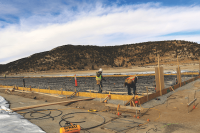
When most people think of radiant heat or hydronic snow melt, the usual applications come to mind: warm floors, heated sidewalks and snow-free driveways. The Big Bear Area Regional Wastewater Agency (BBARWA) in Big Bear, Calif., contacted Viega Radiant Design Services with a project that needed an innovative solution. A byproduct of the water treatment process is sludge which must be hauled by a truck to an off-site disposal area. BBARWA needed to reduce the water content and weight of the sludge, making it less expensive to haul. BBARWA tried several different methods to dry the sludge with only marginal success, so they decided to devise a new system that would be more effective, more efficient and would reduce the odor complaints.

Viega Radiant Design Services worked on the specifics of the slab-heating system design, focusing on what would be required to generate enough heat from the slab to meet the sludge-drying objectives. Viega design engineers used finite element analysis (FEA) to determine the optimum tubing size, spacing and install-depth in the slab based on the water temperature supplied from the diesel generator’s exhaust. Due to the shape and size of the 315- by 60-foot heated slab, it was clear that this project was an excellent application for Viega’s revolutionary Viega Climate Mat® system.

Within the first year alone, the new system saved approximately $200,000 in transportation and fuel costs. Additionally, the project received the California Water Association Desert Mountain Award for Innovation.

For more information on Viega system solutions, visit Viega.us.
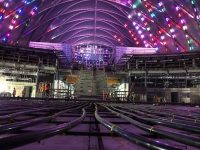
Centrally located in Orange County, California, the Anaheim Regional Transportation Intermodal Center (ARTIC) provides transportation service for three million local residents as well as 40 million annual visitors. A LEED Platinum-certified building, the structure is 67,000 square feet with three levels. ARTIC’s unique architecture includes a large number of windows and a dome-shaped structure, which Read more

Centrally located in Orange County, California, the Anaheim Regional Transportation Intermodal Center (ARTIC) provides transportation service for three million local residents as well as 40 million annual visitors. A LEED Platinum-certified building, the structure is 67,000 square feet with three levels.

ARTIC’s unique architecture includes a large number of windows and a dome-shaped structure, which results in high solar gains. Due to ARTIC’s size, controlling the climate inside the building with a conventional forced-air system would have been nearly impossible.

Instead, HVAC designers for the project chose to implement a radiant heating and cooling system. Radiant cooling allows instantaneous removal of heat through absorption. Installing ViegaPEX™ Barrier tubing at tightly spaced increments (6 inches on-center) allows it to be within two inches of the finished surface floor, which gave the engineer the ability to immediately remove the solar sensible gain. For the ARTIC project, the cooling capacity ranges up to 40 btuh/sq. ft. This provides an energy savings of 34 percent over ASHRAE 90.1-2007.

“We installed 44,000 feet of in-slab heating and cooling pipe, 18 manifolds and 12 pumps,” said Paul Redgate, Pipe Fitting Superintendent for California Comfort Systems. “We’ve done some smaller stuff but nothing on this scale.”
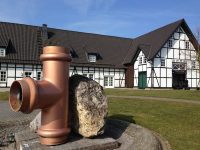
When you step inside the Schnellenberg Castle, you can’t help but feel like you’ve stepped back in time, defending your honor while fending off enemies of yesteryear. While attending the ISH show in Frankfurt, Germany, this past March, I was able to join a Viega facility tour in Attendorn, and the first night was at Read more

When you step inside the Schnellenberg Castle, you can’t help but feel like you’ve stepped back in time, defending your honor while fending off enemies of yesteryear. While attending the ISH show in Frankfurt, Germany, this past March, I was able to join a Viega facility tour in Attendorn, and the first night was at the venerable Burg Scnellenberg Castle, which has since been renovated as a hotel. (See Sidebar, below, for History)

I picked up the Viega tour right after the ISH Show and first thing Monday morning we met with Andre Irie, production manager, for a plant tour in Attendorn. With nearly 500 employees, 300 in production and 200 in logistics, the plant is run to peak efficiency. Seeing where Viega’s ProPress fittings and ball valves are assembled made me pause to think of the facility’s impressive logistics, impeccable testing processes and some 21st Century robotics and technology—especially in the fully automated 25-meter high bay area.
Within the plant’s Logistics facility, quality in products and service is the driver, with productivity consisting of high-level automation; quality second to none; availability; and a service offering differentiated from its competitors.
Seeing the facility is impressive, for sure, but some of the “meat” of the tour was to talk about Viega’s water quality campaign, a domestic and global initiative aimed at educating the industry and providing system solutions to help maintain water quality for commercial potable water systems. Viega’s water quality campaign focuses on the Viega system solutions to help the engineering community design systems that minimize the risk of waterborne pathogens. Promoting hot water recirculation and keeping water at the correct temperature can help reduce the opportunity for bacteria to colonize.
For me, it was listening to Stefan Schulte, Viega’s product manager, Valves Business Unit Innovation, demonstrating proper water flow and talking about contamination through stagnation times, growth temperatures, and unsuitable materials breeding unwanted microorganisms. It was Derek Bower, Viega’s director product management, Metals, discussing planning and operation of hygienic water installations and risk minimization of bacteria such as Legionella through temperature, water stagnation and “dead legs” by explaining ring and series water flow. “Viega will be a product system solution provider,” says Bower.

Viega’s Stefan Schulte, Product Manager – Valves Business Unit Innovation, demonstrates proper water flow.
Upon completion of the Viega plant tour in Attendorn, we traveled to a jobsite—a water quality site visit—which is a 17-unit home site under construction just outside Frankfurt. The gist of this high-efficiency apartment building site visit—which featured radiant heating, a well-insulated envelope and multiple ERVs—was to see Viega’s water quality stamp in a real-time installation. All of the pipes were insulated — hot and cold. The basement was plumbed in a series system for the multiple washing machine set-up, and Viega Venturi fittings were used keep the flow of water continuous, drawing water through the gardener’s tap even if it isn’t used regularly.
“By plumbing systems in series, or daisy chaining them together and using a Venturi fitting to induce flow through seldom used, remote fixtures, flow is promoted and temperature maintained in fixtures that are seldom used, thereby reducing the opportunity for microbial pathogens to colonize,” says Bower.
Continuing Education
Viega is extending its free training course on reducing the risk of microbial growth in commercial plumbing systems in five locations throughout the U.S. The training course is part of Viega’s water quality campaign, a domestic and global initiative aimed at educating the industry and providing system solutions to help maintain water quality for commercial potable water systems.
Titled, “Pathogen Control by Design,” the one-day training course is co-presented by Jason McKinnon, director of training, Viega, and Tim Keane, consultant with Legionella Risk Management Inc., who is one of the country’s leading experts in methods to control and minimize the risk of Legionella. Keane has 25 years of experience in industrial and commercial water treatment consulting, focusing on waterborne pathogen control, and regularly makes presentations on groundbreaking issues related to Legionnaires’ disease. He has presented at the American Water Works Association (AWWA) 2012 Water Quality Technology Conference, the International Emerging Technology Symposium and the 2014 American Society of Plumbing Engineers (ASPE) Convention.
The course will cover case studies of Legionnaires’ disease outbreaks, Legionella guidelines and standards from a liability perspective, and design factors that impact pathogen control. Where applicable, continuing education credits are available.
The 2015 course schedule is offered in Chicago, Ill. on July 21; in Houston, Tex. on September 1 and in New York City on October 22.
For more information or to register for Viega’s water quality seminar, visit: Viega.us/training.

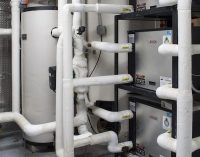
Homes on Providence’s historic East Side often come with an enviable address, lovely views and antiquated heating systems. Such was the case last year with a 12,000-sq.-ft. home on the East Side with a view overlooking the state capitol. A new buyer decided to completely renovate the home and install a new HVAC system using Read more

Homes on Providence’s historic East Side often come with an enviable address, lovely views and antiquated heating systems. Such was the case last year with a 12,000-sq.-ft. home on the East Side with a view overlooking the state capitol. A new buyer decided to completely renovate the home and install a new HVAC system using state-of-the-art technologies including geothermal, in-floor radiant and hydro-air.
Going with Geothermal
TJ’s Plumbing and Heating, Inc., Attleboro, Mass., a firm with expertise in designing and installing geothermal, radiant and solar thermal systems, was the HVAC contractor awarded the contract by the owner, in conjunction with the home renovation contractor, Parker Construction of East Providence, R.I., which specializes in custom luxury homes. Tim Cutler, owner of TJ’s, has been doing geothermal installations for around 10 years, mostly for high-end homes, both new construction and retrofits, and he has seen a 30% growth in his firm’s business stemming directly from geothermal.

With an aged heating system fired by an oil-fired steam boiler, coupled with the new owner’s desire not to have any HVAC equipment situated outside the home for aesthetic reasons, TJ’s challenge was to deliver the ultimate comfort system without compromising the home’s integrity. To accomplish this task they provided a design-build alternative energy system for both heating and cooling, attaining a comfortable indoor environment year-round with a water-to-water geothermal system as the centerpiece of the home energy system.
According to Cutler, vertical bore holes work best in New England’s rocky soil. With sufficient property available for drilling six 550-ft. bore holes for the geothermal system, TJ’s selected and installed three Bosch-FHP 6-ton, two-stage water-to-water TW071 Series heat pumps in the home’s mechanical room. TW Series units feature a two-stage scroll compressor and floating base pan for quiet, high efficiency performance. Unless peak capacity is required, the units can run at roughly two-thirds capacity, at significantly higher efficiencies than other geothermal heat pumps. For backup heat and domestic hot water needs, TJ’s installed a Viessmann gas-fired condensing boiler.
The home has a total eight bathrooms on three floors, and to keep its floors warm underfoot, as well providing in-floor heat for most of the first floor, TJ’s installed a Viega radiant heat system. The firm also installed seven zones of hydro-air using chilled water for cooling and 120° design water temperature for heating. Custom designed sheet metal was used to fit into the home without compromising the home’s integrity or elegance.
Ensuring high indoor air quality
To ensure the highest IAQ and to also provide radon removal, TJ’s installed a Zehnder ComfoAir 350 unit to constantly change the home’s indoor air. This system works continuously to extract moist, stale air from wet rooms (kitchen, bathrooms, utility rooms and closets) and supply fresh, filtered air to habitable rooms. Up to 90% of the heat in the extracted air, which would otherwise be exhausted outside the home, is recovered by the heat exchanger in the ComfoAir unit to temper incoming supply air. To manually increase airflow if needed, TJ’s installed a wall-mounted Zehnder control.
The Federal tax credit’s importance
Since the home’s completion and occupancy last fall, TJ’s reports that the geothermal system has operated as designed and has fully met the client’s expectations. In addition to the concerns about energy efficiency savings and environmental considerations, a driving factor for many of TJ’s geothermal clients is the 30% federal tax credit, a credit that Cutler, and the geothermal industry, would like to see continued beyond 2016.
Project Details:
General Contractor: Parker Construction, East Providence, RI
HVAC: TJ’s Plumbing and Heating, Attleboro, MA
Geothermal Well Driller: Skillings & Sons, Amherst, MA
Interior Designer: Scarborough Phillips Design, West Warwick, RI
Wholesaler: Delta T, Warwick, RI
Bosch Thermotechnology and TJ’s Plumbing and Heating supplied information for this case study. Tim Cutler, owner of TJ’s, is an Accredited Bosch Contractor. He is also IGSHPA and NATE Geo certified.
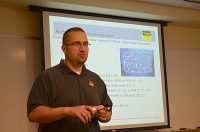
Wichita, Kan. — Viega announces two radiant training seminars in 2015 for design-build contractors and engineers. Viega, in collaboration with the Center for the Built Environment (CBE), at University of California, Berkeley, is holding the one-day training courses, titled, “Energy and Comfort Performance of Radiant Slab Systems.” The courses are co-presented by Fred Bauman, a Read more
Wichita, Kan. — Viega announces two radiant training seminars in 2015 for design-build contractors and engineers.
Viega, in collaboration with the Center for the Built Environment (CBE), at University of California, Berkeley, is holding the one-day training courses, titled, “Energy and Comfort Performance of Radiant Slab Systems.” The courses are co-presented by Fred Bauman, a prominent scientist at CBE, and Jason McKinnon, director of training, Viega.
Viega recently announced a partnership with the CBE. Educating the industry on new and more efficient technologies for commercial integrated hydronics systems was one of the initial goals of the association between the two organizations.
The radiant training seminars are scheduled for May 13, 2015 in Washington D.C. and November 3, 2015 in San Francisco. The seminars will teach how radiant systems work, heat transfer fundamentals, energy use and thermal comfort in comparison to conventional all-air systems. Project examples and design guidance will also be covered.
“These radiant seminars provide a wealth of industry knowledge,” said Mark Parent, director of product management, Viega. “There is a lack of industry knowledge when it comes to radiant heating and cooling. Our hope is to help educate the industry on newer and more efficient technologies when designing commercial integrated hydronics systems.”
CBE is leading a research program on advanced integrated systems with a focus on radiant slab cooling, also known as thermally activated building systems (TABS). CBE recently accepted a $3 million grant over the next three years on radiant slab systems to research methods for optimizing radiant systems for energy efficiency and comfort.
Viega provides the most versatile radiant heating and cooling systems in the industry. Suitable for residential, commercial or industrial applications, Viega ProRadiant heating and cooling solutions include ViegaPEX™ Barrier tubing, Viega FostaPEX® tubing, Viega PEX Press fittings, manifolds, controls, mixing stations, sensors, mats, panels, tracks and plates.
For more information or to register for one of Viega’s radiant seminars, visit: Viega.us/training.


